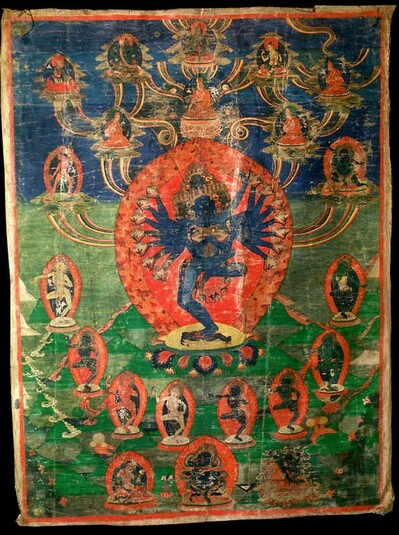
Item: Hevajra (Buddhist Deity)
| Origin Location | Tibet |
|---|---|
| Date Range | 1800 - 1899 |
| Lineages | Sakya and Ngor (Sakya) |
| Material | Ground Mineral Pigment on Cotton |
| Collection | Southern Alleghenies Museum of Art |
Classification: Deity
Shri Hevajra (Tibetan: pal gye pa'i dor je. English: Glorious Joyful Vajra): principle meditational deity of the Sakya School and central focus of the Lamdre cycle of teachings, together with eight goddesses, deities and lineage teachers above and protectors below. (See Hevajra Main Page, Outline Page and Resource Page).
Sanskrit: Hevajra Tibetan: Gye pa dor je
Tibetan: Gye pa dor je
Wrathful in appearance, dark blue in colour with multiple heads and hands he stands in a dancing posture amidst orange flames of wisdom fire. At each side of the central blue face are three further faces with a small fierce face placed above making a total of eight. Each face has three eyes, yellow hair flowing upward, a crown of five skulls and earrings. With sixteen hands each holds a skullcup and a unique object inside. The first pair folded at the heart embrace the consort Vajra Nairatmya, light blue in colour with one face and two hands, holding aloft a curved knife with the right hand, standing embracing the consort with the right leg. Both are adorned with various wrathful ornaments, bones, skull garlands and the like. Atop a series of stacked figures, sun disc and multi-coloured lotus seat they stand completely engulfed in the orange flames of pristine awareness. In a half circle standing in front are the eight goddesses of the Hevajra mandala each with one face and two hands of various colours, holding unique symbolic objects and standing in dancing postures.
At the top center is the primordial buddha Vajradhara, blue, with one face and two hands holding to the heart the stems of two lotus blossoms supporting a vajra and bell. At the left is a mahasiddha, dark in colour, wearing a red meditation belt. At the right is a peaceful figure attired in the garb of a bodhisattva. At the far left is Sachen Kunga Nyingpo (1092-1158), dressed as a layman, holding a white lotus blossom in the right hand. At the far right a lama wears monastic robes and a red pandita hat. Below that are three lamas in a row all wearing monastic robes and performing various mudras. The central figure is seated on a large multi-petaled pink lotus.
At the middle left is Vajrayogini, red, with one face and two hands, in a standing posture. At the right is Bhutadamara Vajrapani, dark blue, wrathful, with one face and two hands.
At the bottom center is the wrathful protector Panjarnata Mahakala, black, with one face and two hands. At the right is the wrathful consort Shri Devi, black, with one face and four hands riding a brown mule. At the left is Brahmarupa Mahakala, in the appearance of an Indian mahasiddha. These are the three main Dharma protectors of the Sakya School.
Hevajra Lineage: Vajradhara, Nairatmya, Virupa, Kanhapa, Damarupa, Avadhutipa, Gayadhara, Drogmi Lotsawa, Seton Kunrig, Shangton Chobar, Sachen Kunga Nyingpo, etc.
Jeff Watt 3-1999
Collection of Southern Alleghenies Museum of Art
Tradition: Sakya Deity Paintings
Buddhist Deity: Hevajra Main Page
Buddhist Deity: Hevajra, Deity Paintings
Collection of Southern Alleghenies: Deity
